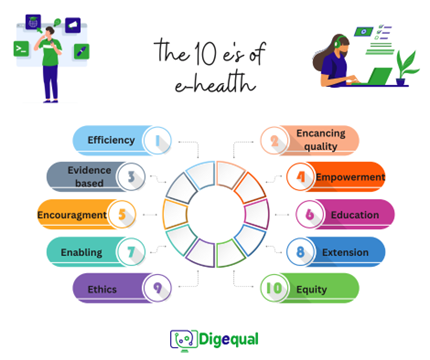1. e-government made simple
5 Topics | 1 Quiz
2. e-health – How technology changes the way we manage our health
7 Topics | 1 Quiz
3. The basics about e-payment
5 Topics | 1 Quiz
4. e-leisure: Be your own tour operator!
5 Topics | 1 Quiz
5. e-participation. Raise Your Digital Voice!
5 Topics | 1 Quiz
Characteristics of e-health: the 10 e’s
The ‘e’ in e-health does not just mean ‘electronic’. It represents a number of e’s that characterise what e-health is all about. The characteristics of e-health or what e-health should comprise of can be illustrated in the following 10 e’s, which according to Eysenbach (2001), are:
- Efficiency
It ensures efficiency in health care by decreasing costs. This can be achieved through avoiding duplicative or unnecessary diagnostic, decreasing overhead cost in practice and involving patients for improving communication. - Enhancing the quality of care
Enhancing the quality of healthcare by allowing comparisons between different providers or directing patient streams to the best quality providers. - Evidence-based
e-health interventions must be evidence-based because their value and competence should not be presumed but proven by laborious scientific assessment. - Empowerment of consumers and patients
e-health incorporates expanding patients’ knowledge and access to personal electronic records over the internet. This unlocks new opportunities for patient-centered medicine and facilitates evidence-based patient choice. - Encouragement
e-health provides encouragement for a new link between the patient and health expert towards a true corporation and more proactive care, where choices are made mutually. - Education
For both patients and healthcare providers, e-health can expand knowledge through research or healthcare information and helps both of them with ongoing medical education. - Enabling
It creates an environment for easier exchange of information and easy communication between the patient and the healthcare provider. - Extension
e-health facilitates patients to achieve health services online from international providers effortlessly. These facilities range from simple advice/suggestions to more compound intermediations or medications. - Ethics
e-health includes new forms of patient-physician communication, poses new challenges, and pressures ethical issues, for instance, online professional practice, informed consent, privacy and equity issues. - Equity
e-health is and should be equitably accessible to all people, irrespective of their age, race, gender, ethnicity etc. People whose economic conditions are poor and lack skills and access to computers and networks cannot use computers efficiently. As a result, these patient populations are the least expected to benefit from developments in information technology. The digital gap presently runs between rural vs urban inhabitants, rich vs poor, young vs old, male vs female people, and neglected/rare vs common illnesses.

